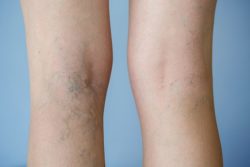Our veins are important: they transport blood back to the heart to get re-oxygenated. It’s important to keep these vital pathways to the heart healthy. Many people experience some form of vein disease by the time they reach 60 years of age, and making sure you know what to look out for is important to catch potential problems early.
Dayton, Ohio residents can rest assured knowing Varicose to Perfect is an accredited institution dedicated to high-quality, compassionate care.

Vein disease is very common: 70 percent of women and 40 percent of men are affected by at least one of the several types. These include deep vein thrombosis, varicose veins, and edema, and they can develop in different ways.
In some cases, vein disease is genetic — passed down through families — or it develops as a result of excessive weight gain, pregnancy, or activities that put pressure on the veins such as running, jogging, and bodybuilding.
Varicose veins are noticeably large, blue- or purple-colored segments of valves that become damaged. They appear blue or purple because the blood carried in veins is returning back to the heart without oxygen, and blood loses its deep red color after it has delivered oxygen to the body.
When these veins are damaged, they don’t allow de-oxygenated blood to pass as easily, leading to pain and cramping where they appear. Varicose veins are often mistaken for spider veins due to their similar look, but spider veins are smaller and closer to the surface of the skin.
Edema is a vein disease caused by fluid buildup and fluid leakage in the blood vessels. You may notice this as swelling in certain areas like ankles or hands. It can result from standing or sitting in the same position for a prolonged period, high salt intake, premenstrual symptoms, or even pregnancy. Pulmonary edema is a serious medical condition characterized by shortness of breath, chest pain, and difficulty breathing and should be treated as an emergency.
A similar condition called deep vein thrombosis can appear without any symptoms. However, a person suffering from deep vein thrombosis will eventually notice swelling in the leg, ankle and foot, pain and the sensation of a cramp or charley horse, a paleness or reddish or bluish tint to the skin and warmth over the affected leg.
The condition can also lead to a pulmonary embolism, which means that if additional symptoms appear, it is absolutely essential to seek immediate medical attention.
Discuss your treatment options with Dr. Sukir Sinnathamby to keep your veins and body healthy by scheduling a consultation today.
